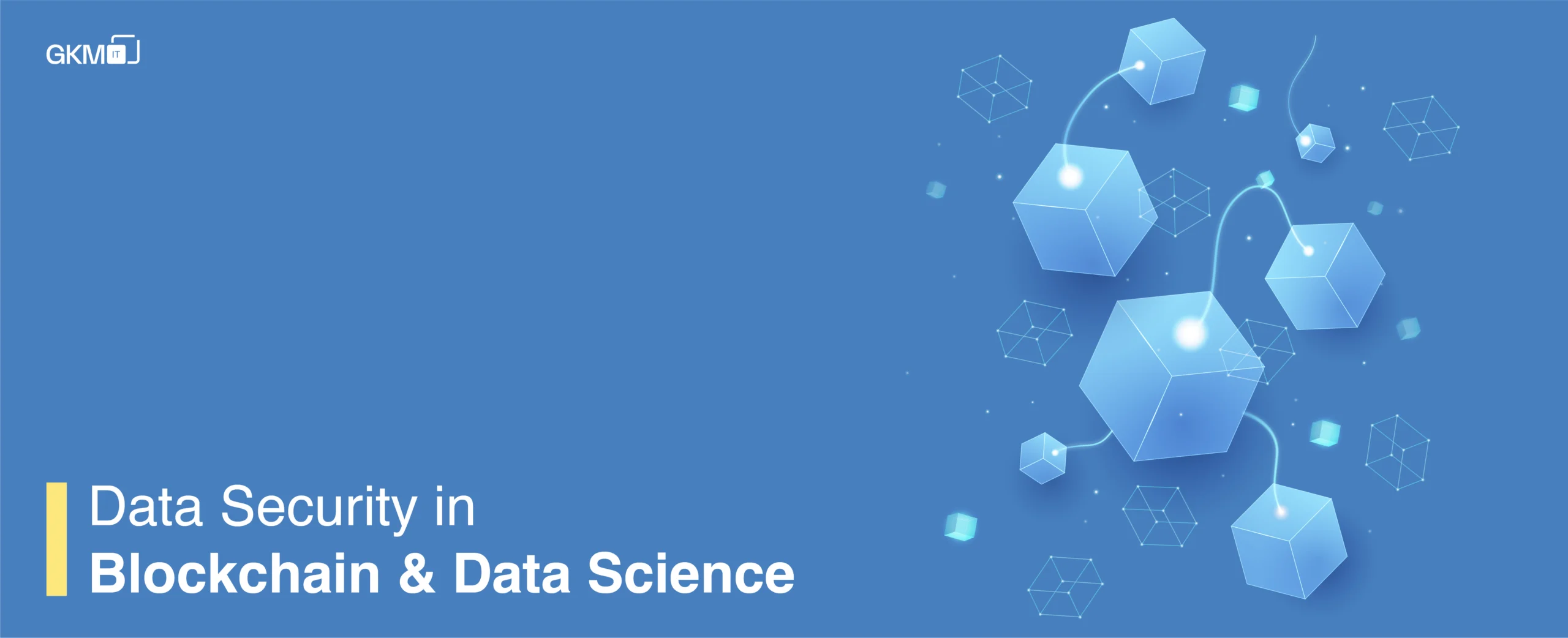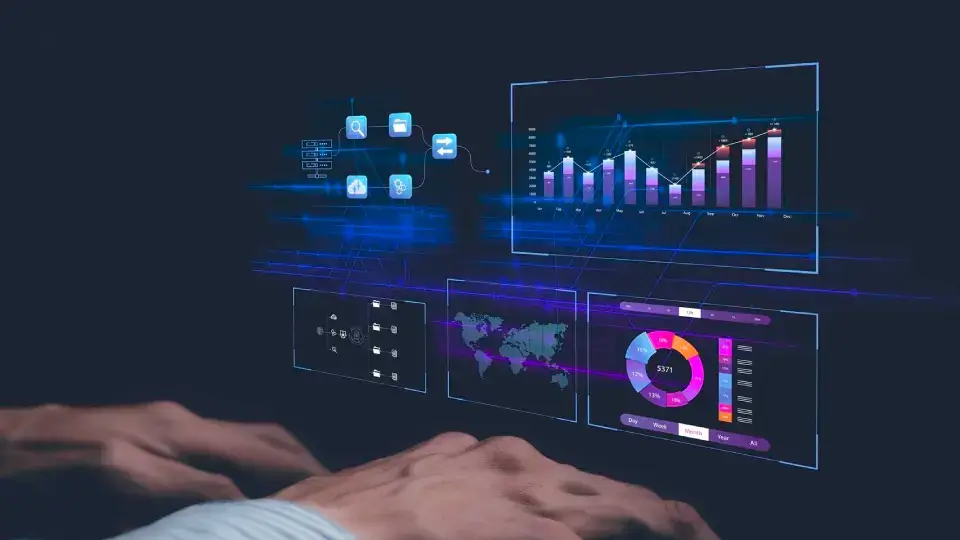
Data Security: Blockchain & Data Science | GKM IT
Blockchain is responsible for storing records and validating data, while data science works towards delivering valuable insights for troubleshooting and decision-making. Both technologies employ algorithms to communicate with other data segments. Put in simple words, blockchain deals with data integrity and data science is applied to predictions.
In this blog, we’ll be discussing how blockchain and data science contribute to data security. For those of you who aren’t familiar with Blockchain and Data Science, we’ll brief you before moving on to the main topic.
What is Blockchain?

Blockchain is a decentralized digital ledger that securely records data across multiple computers. Each new block contains a reference to the previous one, creating an immutable chain of information. Though this technology is widely known for backing cryptocurrencies like Bitcoin, it has numerous other applications in various industries beyond the realm of digital currencies.
The word ‘blockchain’ is a combination of two separate terms, ‘block’ and ‘chain.’ A block basically refers to a collection of data, and ‘chain’ refers to a public database made up of these blocks, stored as a list.
These lists are linked together with the help of cryptography. This linking caters to assembling a very critical and fundamental need for creating a blockchain. In simpler words, a blockchain is a multiplying list of data to which the blocks get connected over time.
Fortune Business Insights reported that the global blockchain technology market size was valued at $11.14 billion in 2022. According to the forecast, it will grow from $17.57 billion in 2023 to $469.49 billion by 2030 at a CAGR of 59.9%.
What is Data Science?

Data science is the process of studying data to find valuable insights for business purposes. It involves using a mix of disciplines, such as mathematics, statistics, artificial intelligence (AI), and computer engineering, to analyze large datasets.
Markets and Markets recently reported that the Global Data Science Platform Market size was valued at USD 95.5 billion in 2021. As per its prediction, it will grow to USD 322.9 billion in 2026 at a CAGR of 27.7%.
How Blockchain and Data Science Impact Data Security?

Blockchain and data science play crucial roles in enhancing data security through various mechanisms and techniques. Here’s how they contribute:
Immutable Data Storage:
Blockchain technology’s immutable data storage offers a different level of successful security in which any action or transaction cannot be duplicated, deleted, or altered. The tamper-proof functionality heightens data integrity and safeguards against unauthorized modifications.
Cryptographic Techniques:
Blockchain and data science in data security apply advanced cryptographic algorithms to safeguard data during transmission and storage. This guarantees that only authorized parties can access and decrypt the sensitive information. Furthermore, the application of cryptographic techniques in blockchain and data science offers an extra layer of protection against data breaches and unauthorized access attempts.
The foundation skills of cryptography offer us sufficient confidence and trust in data sharing as it effectively enables access to sensitive data only to authorized parties.
Identity Management:
Identity management (IdM) or identity and access management (IAM), allows access strictly to authorized people only. This authority enables access to technological resources they’d require to perform their tasks. Policies and technologies consisting of the organization’s process are granted access. This access ensures the appropriate handling and protection of sensitive information, maintains data integrity and enforces security measures across the system.
While blockchain’s distributed ledger can serve as a decentralized IdM system, data science techniques in data security can contribute to analyzing and verifying user identities, simultaneously reducing the risk of unauthorized access.
Smart Contracts:
Smart contracts are blockchain-based agreements that are coded and stored on the blockchain. They automate agreements between parties, making them unchangeable and final. Their main goal is to execute agreements automatically without intermediaries, ensuring instant confirmation for all involved parties.
Let us help you understand better with examples. In online gaming, smart contracts enforce the rules of the game and manage in-game assets and transactions between players. Insurance policies can be implemented as smart contracts as well. For instance, a flight delay insurance contract could automatically pay out compensation to the insured party if the flight is delayed for a specified amount of time, verified through trusted external data sources.
In this contract, blockchain in data security allows predefined agreements to be automatically executed. Data science analyzes the contract’s performance and ‘trigger actions’ pertaining to data-driven conditions by further ensuring data security.
Anomaly Detection:
Anomaly detection is a process in data mining that recognizes data points, events or observations that divert from the datasets’ normal behavior. Using machine learning and deep learning technologies, data science detects anomalies and potential security threats in large datasets. This adds an extra layer of protection with blockchain’s transparent monitoring and auditing of data access.
Decentralization and Distributed Storage:
In a decentralized system, control is spread out among its components, while in a distributed system, the components in a distributed system are physically distan
t from each other and communicate through a network.
Blockchain in data security is decentralized in nature and ensures that the data is not stored in one location. This brings down the risk of single-point failure or data loss. Data science in data security plays the role of optimizing data distribution for redundancy and efficiency.
Consensus Mechanisms:
The general meaning of consensus is that a majority of people in a group are in favor of a decision. In blockchain, consensus must have at least 51% of the concerned people in favor of the decision.
A consensus mechanism in the blockchain is a system that authenticates a transaction and marks it as valid. It validates all transactions of cryptocurrencies like Bitcoin and Ethereum in blockchain to build trust amongst the traders. Consensus algorithms make sure that the participants are in agreement with the authorization of data. Data science assists blockchain in data security by evaluating and enhancing the consensus protocols to heighten security.
Conclusion
The integration of data science and blockchain in data security has been enhancing data security in several ways and will continue to do so with the help of artificial intelligence, machine learning, and deep learning technologies.
We have discussed the basics of blockchain and data science in data security, along with their market values. Deeper insights have been shared on how the two technologies (blockchain & data science) impact and enhance the quality of data security.
Share with us your feedback/suggestions/queries in the comments sections.
Related Blogs –
Blockchain technology potential in different sectors other than cryptocurrency